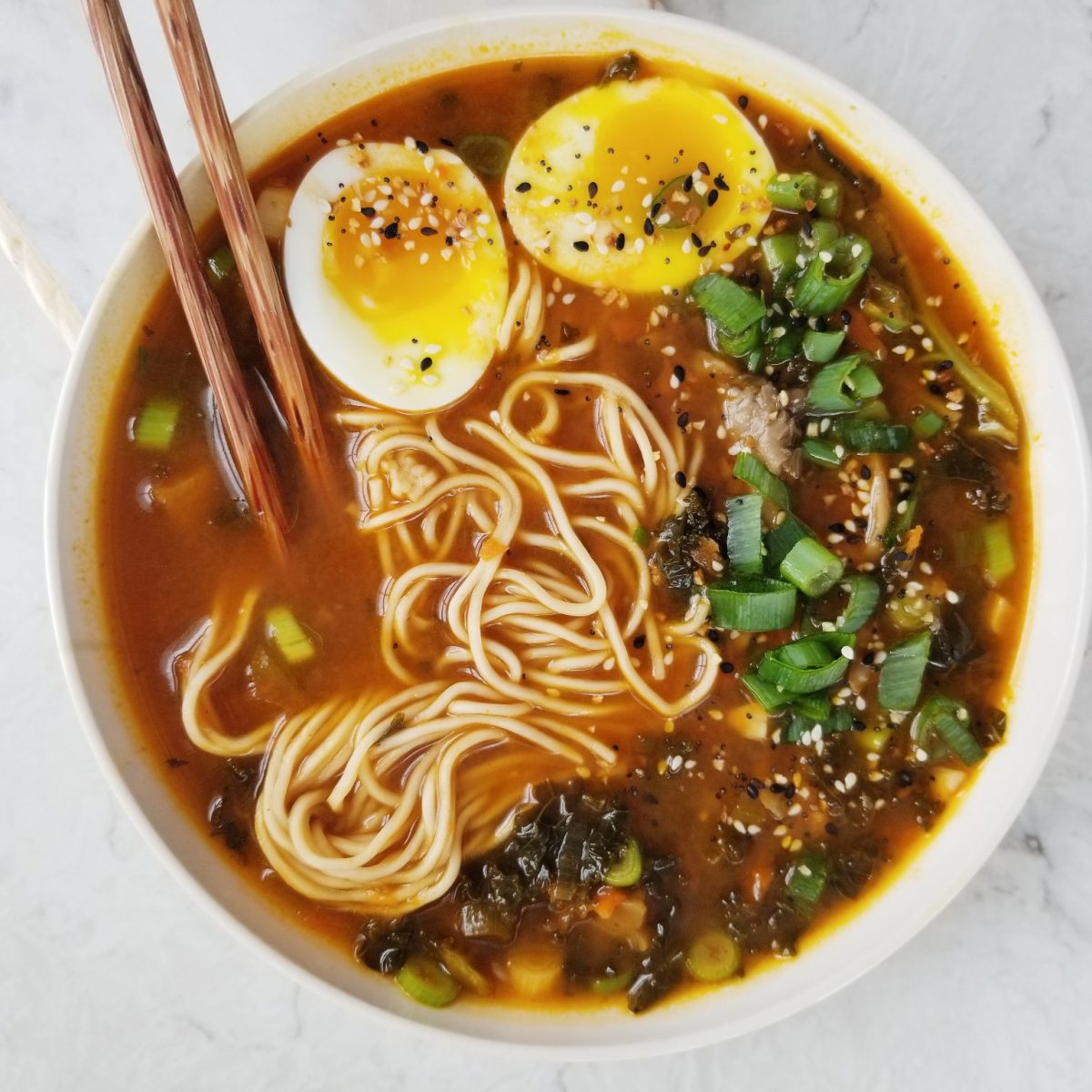Craving the vibrant flavors of Asian noodle bowls but avoiding soy sauce? This guide unveils a world of delicious possibilities, showcasing how easily you can create authentic and satisfying bowls without relying on this common ingredient. We’ll explore a spectrum of flavorful alternatives, noodle varieties, and exciting broth bases, transforming your culinary experience into a journey of discovery.
Prepare to embark on a culinary adventure as we delve into the art of crafting delectable Asian noodle bowls that are both soy-free and bursting with flavor. From mastering the art of noodle preparation to selecting the perfect protein and vegetable combinations, we’ll guide you step-by-step, ensuring each bowl is a symphony of textures and tastes. Get ready to unleash your inner chef and create noodle bowls that will tantalize your taste buds!
Delicious Alternatives to Soy Sauce

Soy sauce, a cornerstone of Asian cuisine, lends its characteristic salty-umami flavor to countless dishes. However, for those with soy allergies, following a specific diet, or simply seeking culinary variety, exploring delicious alternatives is essential. These alternatives offer unique flavor profiles that can elevate your Asian noodle bowls to new heights.
Soy Sauce Alternatives: Flavor Profiles and Comparisons
Three compelling alternatives to soy sauce—coconut aminos, tamari, and fish sauce—each bring a distinct taste to the table. Coconut aminos, derived from coconut sap, offer a subtly sweet and savory profile with a hint of caramel. Tamari, a gluten-free soy sauce variant, retains the familiar umami punch of soy sauce but with a richer, more complex flavor. Fish sauce, fermented from anchovies, delivers a potent, intensely savory umami with salty notes and a distinctive, slightly pungent aroma. While all three provide umami, their intensity varies. Fish sauce boasts the most robust umami, followed closely by tamari, with coconut aminos offering a gentler, sweeter umami experience. The choice depends entirely on your desired flavor profile and dietary needs.
Umami Levels of Soy Sauce Substitutes
The umami, or savory, quality is a key characteristic of soy sauce and its alternatives. A comparison of the umami intensity reveals a spectrum of savory depth. Fish sauce, with its concentrated anchovy essence, delivers the most powerful umami punch. Its deep, briny flavor is unmistakable. Tamari, while still potent, presents a slightly less intense umami compared to fish sauce, offering a more refined savory note. Coconut aminos, in contrast, provide a milder, sweeter umami, adding a subtle savory depth without overpowering other flavors in the dish. The difference in umami intensity directly impacts the overall flavor profile of the noodle bowl, allowing for a nuanced approach to seasoning.
Comparison Table of Soy Sauce Alternatives
| Alternative | Ingredients | Flavor Profile | Vegetarian/Vegan |
|---|---|---|---|
| Coconut Aminos | Coconut sap | Subtly sweet, savory, hint of caramel | Vegan |
| Tamari | Fermented soybeans, water, salt | Rich, complex umami, salty | Vegetarian |
| Fish Sauce | Fermented anchovies, salt, water | Intense umami, salty, pungent | Neither |
Noodle Variety and Preparation
Choosing the right noodles is crucial for a delicious and satisfying Asian noodle bowl. The texture and flavor of the noodles significantly impact the overall eating experience, complementing the other ingredients beautifully. Understanding the characteristics of different noodle types and mastering their preparation is key to creating a truly authentic and flavorful bowl.
The following sections detail five popular Asian noodle types, their unique textures, and optimal cooking methods. Each noodle type offers a different culinary experience, allowing for versatility in your noodle bowl creations.
Five Asian Noodle Types and Their Preparation
This section explores five distinct types of Asian noodles: rice noodles, wheat noodles, soba noodles, udon noodles, and ramen noodles. Each possesses unique characteristics that lend themselves to different culinary applications and textures.
Rice Noodles: These delicate noodles, made from rice flour, offer a subtly sweet and chewy texture. Their smooth, almost translucent appearance is visually appealing. They are incredibly versatile and work well in both hot and cold dishes. Rice noodles are typically thin and flat, though wider varieties exist. Their neutral flavor allows the other ingredients in your noodle bowl to shine.
Wheat Noodles: These noodles, common in many Asian cuisines, come in a wide variety of shapes and thicknesses. They can range from thin and delicate to thick and chewy. Their taste is typically mild, providing a good base for bolder sauces and flavors. The cooking time varies depending on the thickness, with thinner noodles cooking faster.
Soba Noodles: Made from buckwheat flour, these noodles have a distinctive earthy aroma and slightly nutty flavor. They are typically brown in color and have a firm, slightly chewy texture. Soba noodles are often served cold in summer, but they are equally delicious in warm noodle bowls, particularly those with lighter broths or sauces.
Udon Noodles: These thick, white wheat noodles are known for their incredibly chewy texture. They are often served in hot noodle soups, their substantial nature holding up well to flavorful broths. Udon noodles possess a mild, almost bland flavor, making them ideal for absorbing rich and savory sauces.
Ramen Noodles: These alkaline wheat noodles have a characteristic yellow color and a firm, slightly bouncy texture. They are often served in rich broths, their flavor profile complementing the savory and umami elements of the soup. The alkaline nature contributes to their unique texture and ability to hold their shape even when submerged in broth.
Step-by-Step Noodle Preparation
Precise cooking is essential to achieve the optimal texture for each noodle type. Overcooking can lead to mushiness, while undercooking results in a tough and unpleasant bite.
Rice Noodles: Soak dried rice noodles in warm water for 15-20 minutes until softened. Then, gently simmer in boiling water for 2-3 minutes until tender but still slightly firm. Avoid overcooking, as they can become gummy. Rinse with cold water to stop the cooking process and prevent sticking.
Wheat Noodles: Bring a large pot of salted water to a rolling boil. Add the noodles and cook according to package directions, typically 3-5 minutes for thin noodles and 5-7 minutes for thicker varieties. Drain immediately and rinse with cold water to prevent sticking.
Soba Noodles: Similar to wheat noodles, bring salted water to a boil. Add soba noodles and cook for 3-5 minutes, or until al dente. Drain and rinse with cold water for a refreshing texture.
Udon Noodles: Udon noodles benefit from a longer cooking time. Bring salted water to a boil, add the noodles, and cook for 8-10 minutes, or until tender but still slightly chewy. Drain and rinse under cold water to maintain their texture.
Ramen Noodles: Cook ramen noodles according to package directions, usually 2-3 minutes in boiling water. Drain and rinse under cold water to prevent sticking. The cooking time is shorter than other noodle types because of their thinner gauge.
Optimal Cooking Methods for Asian Noodles
The cooking method significantly impacts the final texture and taste of the noodles. Choosing the appropriate method is key to achieving the desired result.
A summary of best practices for each noodle type is provided below. Remember to always adjust cooking times based on noodle thickness and personal preference for texture.
- Rice Noodles: Soaking followed by a quick simmer in boiling water is ideal. Steaming can also be used, but requires careful monitoring to avoid overcooking.
- Wheat Noodles: Boiling in salted water is the most common and effective method. Pan-frying can add a nice crispy texture to some types of wheat noodles.
- Soba Noodles: Boiling is the preferred method, ensuring even cooking and maintaining the noodle’s integrity.
- Udon Noodles: Boiling is essential for achieving the characteristic chewy texture. Steaming can also be used but requires more time and attention.
- Ramen Noodles: Boiling is the standard method. Pan-frying can also be used to create a crispier texture, particularly if used in stir-fries.
Creating delicious Asian noodle bowls without soy sauce is surprisingly simple and incredibly rewarding. By exploring the diverse world of alternative sauces, noodle types, and flavorful broths, you can craft bowls that are uniquely your own. Remember, the key lies in experimenting with different flavor profiles and textures to find your perfect combination. So, gather your ingredients, embrace your creativity, and get ready to savor the incredible results of your culinary exploration!
Helpful Answers
Can I use tamari instead of soy sauce?
Tamari is a soy sauce alternative, but it still contains soy. If you have a soy allergy, avoid it. Consider coconut aminos or fish sauce as alternatives.
What are the best vegetables for Asian noodle bowls?
Many vegetables work well! Consider broccoli, carrots, bok choy, mushrooms, bell peppers, snow peas, bean sprouts, edamame, zucchini, and scallions for a variety of textures and flavors.
How do I store leftover noodle bowls?
Store leftover noodle bowls in an airtight container in the refrigerator for up to 3 days. Reheat gently on the stovetop or in the microwave.
Are coconut aminos a good soy sauce substitute?
Yes, coconut aminos offer a slightly sweet and savory flavor profile, making them a popular soy sauce alternative in many Asian-inspired dishes. They are also gluten-free and vegan-friendly.


